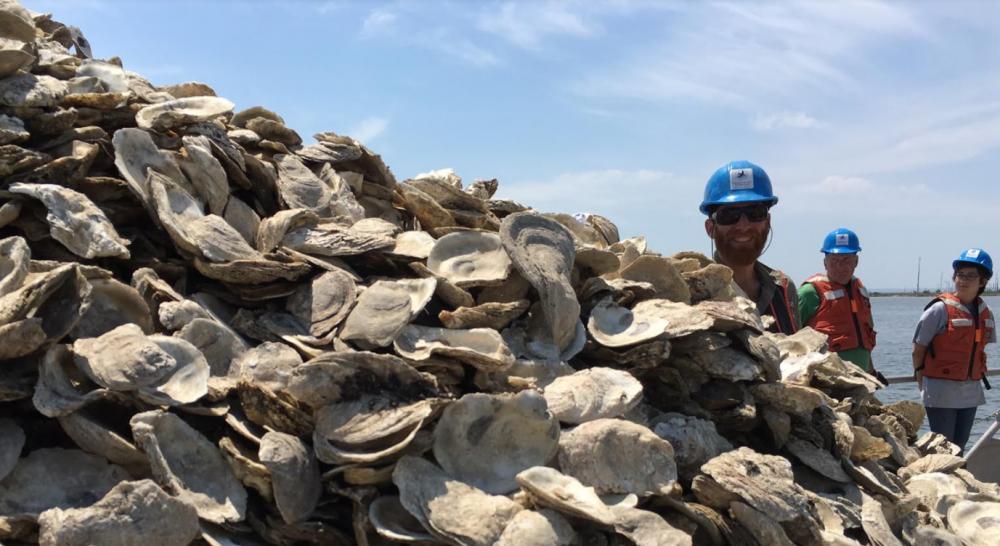New scientific information unveiled Monday, July 10 provides yet more encouraging news that the largest man-made oyster restoration project in the Chesapeake Bay is working. The project is in Harris Creek.
Unfortunately, just as the investment in Harris Creek seems to be paying off, efforts to duplicate that success in two other tributaries of the Choptank River are hitting snags. Political pressure and substrate shortages threaten to bring restoration efforts to a screeching halt if the Maryland Department of Natural Resources (DNR) does not act quickly.
 First the good news. New monitoring data indicate that 30 oyster reefs created in 2013 in Harris Creek have high densities of oysters, reported Stephanie Reynolds Westby, Chesapeake Bay oyster restoration coordinator for the National Oceanic and Atmospheric Administration (NOAA). Westby reported the findings at the monthly meeting of the Maryland Oyster Advisory Commission (OAC). The NOAA report can be found here.
First the good news. New monitoring data indicate that 30 oyster reefs created in 2013 in Harris Creek have high densities of oysters, reported Stephanie Reynolds Westby, Chesapeake Bay oyster restoration coordinator for the National Oceanic and Atmospheric Administration (NOAA). Westby reported the findings at the monthly meeting of the Maryland Oyster Advisory Commission (OAC). The NOAA report can be found here.
Scientists have developed specific metrics to determine when an oyster reef can be officially called “restored.” About 97 percent of the 30 reefs planted in 2013 in Harris Creek met the minimum metric for oyster density, and 80 percent met a higher “targeted” density. In fact, only one of the 30 reefs failed to meet the metrics. OAC members speculated someone could have poached oysters off that reef, or that the seabed underneath could have been too muddy for the oysters to thrive.
Despite data to the contrary, some OAC members challenged the conclusion that a restoration project is successful simply because it achieves metrics such as oyster density and biomass. They said putting oysters in the water and having them grow and prosper is not enough. The real success will be if oysters at Harris Creek reproduce, and their larvae help seed oyster bars miles away where oystermen harvest. Some scientific modeling from the University of Maryland Center for Environmental Science has suggested that could happen.
Scientists at the OAC meeting said a restored reef is successful even if it doesn’t seed far-away oyster reefs. They said a massive network of reefs such as in Harris Creek will attract fish, filter the water and provide other ecological benefits. Harris Creek is a “sanctuary reef,” meaning oysters can’t be harvested there.
Now the bad news. Also at the OAC meeting, officials with the Maryland Department of Natural Resources (DNR) and the U.S. Army Corps of Engineers (USACE) revealed oyster restoration in the Little Choptank and Tred Avon Rivers have hit political snags. Those two projects were meant to duplicate the success in Harris Creek – building large networks of man-made reefs where oysters had once thrived.
Chris Judy of DNR reported that the plan for Maryland to restore 118 acres in the shallow reaches of Little Choptank is still on hold. For several years DNR has delayed requesting a permit for the work, most recently after complaints from watermen representatives. Restoration work at the mouth of the river has nearly been completed by various partners, including the Chesapeake Bay Foundation, but DNR has long delayed doing its part.
DNR recently asked NOAA experts to further survey the bottom of the river where restoration was planned to find additional suitable acres for restoration in deeper water. Initial estimates suggest that there may be as few as 20-30 acres of suitable area in deeper water, meaning a permit would still be required to complete the project. Because of these political delays and additional surveys, Judy estimated that construction in the Little Choptank won’t begin for a least a year, bringing restoration in the Little Choptank to a halt.
Also at the OAC meeting, Angie Sowers of USACE said her agency had to stop construction in the Tred Avon because of a shortage of mixed shell substrate. The Corps’ contractor was only able to complete 6 out of 10 planned acres. The use of mixed shell instead of other materials in the Tred Avon was a result of negotiations at the OAC after watermen halted restoration work there in 2016. When questioned at the OAC meeting, Sowers said the work could have proceeded with stone.
Ironically, within the new data on Harris Creek was a finding that oysters were growing to densities four times greater on rock substrate than they were on traditional oyster shell. The very thing that watermen object to in reef construction might be the best substance. A recent article in the Chesapeake Bay Journal reported that watermen in Virginia also have discovered the benefit of rock foundations for reefs. But Maryland watermen remain resistant because they claim rock substrate makes it difficult to catch crabs in the area with trot lines, or causes other problems.
Tom Zolper is Assistant Director of Media Relations at the Chesapeake Bay Foundation. For more information about CBF please go here.



Write a Letter to the Editor on this Article
We encourage readers to offer their point of view on this article by submitting the following form. Editing is sometimes necessary and is done at the discretion of the editorial staff.